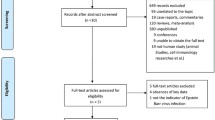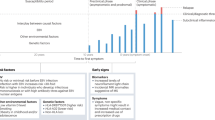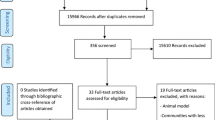Abstract
Numerous studies have been carried out to determine whether infection by the Epstein-Barr virus (EBV) can be considered as a risk factor for multiple sclerosis (MS). This work is a meta-analysis of case–control observational studies published before January 2009 aimed at assessing the degree of association between EBV and MS infections. A Medline electronic database search was carried out using “Epstein-Barr virus” and “multiple sclerosis” as keywords, from which we selected 30 published studies that met our methodology criteria. We found an association between MS and an exposure to EBV, studied by determining the anti-VCA IgG antibodies (odds ratio [OR] = 5.5; 95% confidence interval [CI] = 3.37–8.81; p < 0.0001), anti-complex EBNA IgG (OR = 5.4; 95% CI = 2.94–9.76; p < 0.0001) and anti-EBNA-1 IgG (OR = 12.1; 95% CI = 3.13–46.89; p < 0.0001). No significant association could be found when studying anti-EA IgG (OR = 1.3; 95% CI = 0.68–2.35; p = 0.457), EBV DNA in serum (OR = 1.8; 95% CI = 0.99–3.36; p = 0.051) and DNA in brain tissues and in cerebrospinal fluid (CSF) (OR = 0.9; 95% CI = 0.38–2.01; p = 0.768). This meta-analysis detected an association between infection by EBV and MS through the investigation of antibodies, mainly anti-EBNA-1, anti-complex EBNA and anti-VCA IgG.

Similar content being viewed by others
References
Fernández O, Guerrero M, Fernández VE (2005) Esclerosis múltiple. McGraw-Hill-Interamericana, Madrid
Haahr S, Höllsberg P (2006) Multiple sclerosis is linked to Epstein-Barr virus infection. Rev Med Virol 16:297–310
Salvetti M, Giovannoni G, Aloisi F (2009) Epstein-Barr virus and multiple sclerosis. Curr Opin Neurol 22:201–206
Haahr S, Plesner AM, Vestergaard BF et al (2004) A role of late Epstein-Barr virus infection in multiple sclerosis. Acta Neurol Scand 109:270–275
Haahr S, Koch-Henriksen N, Møller-Larsen A et al (1995) Increased risk of multiple sclerosis after late Epstein-Barr virus infection: a historical prospective study. Mult Scler 1:73–77
Hernán MA, Zhang SM, Lipworth L et al (2001) Multiple sclerosis and age at infection with common viruses. Epidemiology 12:301–306
Nielsen TR, Rostgaard K, Nielsen NM et al (2007) Multiple sclerosis after infectious mononucleosis. Arch Neurol 64:72–75
Ascherio A, Munch M (2000) Epstein-Barr virus and multiple sclerosis. Epidemiology 11:220–224
DeLorenze GN, Munger KL, Lennette ET et al (2006) Epstein-Barr virus and multiple sclerosis: evidence of association from a prospective study with long-term follow-up. Arch Neurol 63:839–844
Sundström P, Juto P, Wadell G et al (2004) An altered immune response to Epstein-Barr virus in multiple sclerosis: a prospective study. Neurology 62:2277–2282
Serafini B, Rosicarelli B, Franciotta D et al (2007) Dysregulated Epstein-Barr virus infection in the multiple sclerosis brain. J Exp Med 204:2899–2912
Thacker EL, Mirzaei F, Ascherio A (2006) Infectious mononucleosis and risk for multiple sclerosis: a meta-analysis. Ann Neurol 59:499–503
Ascherio A, Munger KL (2007) Environmental risk factors for multiple sclerosis. Part I: the role of infection. Ann Neurol 61:288–299
Holmøy T (2008) Vitamin D status modulates the immune response to Epstein Barr virus: synergistic effect of risk factors in multiple sclerosis. Med Hypotheses 70:66–69
Lindberg C, Andersen O, Vahlne A et al (1991) Epidemiological investigation of the association between infectious mononucleosis and multiple sclerosis. Neuroepidemiology 10:62–65
Marrie RA, Wolfson C (2002) Multiple sclerosis and Epstein-Barr virus. Can J Infect Dis 13:111–118
Alotaibi S, Kennedy J, Tellier R et al (2004) Epstein-Barr virus in pediatric multiple sclerosis. JAMA 291:1875–1879
Banwell B, Krupp L, Kennedy J et al (2007) Clinical features and viral serologies in children with multiple sclerosis: a multinational observational study. Lancet Neurol 6:773–781
Pohl D, Krone B, Rostasy K et al (2006) High seroprevalence of Epstein-Barr virus in children with multiple sclerosis. Neurology 67:2063–2065
Alvarez R, Cour I, Kanaan A et al (2000) Detection of viral genomes of the Herpesviridae family in multiple sclerosis patients by means of the polymerase chain reaction (PCR). Enferm Infecc Microbiol Clin 18:223–228
Alvarez-Lafuente R, García-Montojo M, De Las Heras V et al (2008) Herpesviruses and human endogenous retroviral sequences in the cerebrospinal fluid of multiple sclerosis patients. Mult Scler 14:595–601
Ascherio A, Munger KL, Lennette ET et al (2001) Epstein-Barr virus antibodies and risk of multiple sclerosis: a prospective study. JAMA 286:3083–3088
Bray PF, Luka J, Bray PF et al (1992) Antibodies against Epstein-Barr nuclear antigen (EBNA) in multiple sclerosis CSF, and two pentapeptide sequence identities between EBNA and myelin basic protein. Neurology 42:1798–1804
Bray PF, Bloomer LC, Salmon VC et al (1983) Epstein-Barr virus infection and antibody synthesis in patients with multiple sclerosis. Arch Neurol 40:406–408
Buljevac D, van Doornum GJ, Flach HZ et al (2005) Epstein-Barr virus and disease activity in multiple sclerosis. J Neurol Neurosurg Psychiatry 76:1377–1381
Denne C, Kleines M, Dieckhöfer A et al (2007) Intrathecal synthesis of anti-viral antibodies in pediatric patients. Eur J Paediatr Neurol 11:29–34
Ferrante P, Mancuso R, Pagani E et al (2000) Molecular evidences for a role of HSV-1 in multiple sclerosis clinical acute attack. J Neurovirol 6(Suppl 2):S109–S114
Hay KA, Tenser RB (2000) Leukotropic herpesviruses in multiple sclerosis. Mult Scler 6:66–68
Höllsberg P, Kusk M, Bech E et al (2005) Presence of Epstein-Barr virus and human herpesvirus 6B DNA in multiple sclerosis patients: associations with disease activity. Acta Neurol Scand 112:395–402
Morré SA, van Beek J, De Groot CJ et al (2001) Is Epstein-Barr virus present in the CNS of patients with MS. Neurology 56:692
Munch M, Riisom K, Christensen T et al (1998) The significance of Epstein-Barr virus seropositivity in multiple sclerosis patients? Acta Neurol Scand 97:171–174
Mancuso R, Delbue S, Borghi E et al (2007) Increased prevalence of varicella zoster virus DNA in cerebrospinal fluid from patients with multiple sclerosis. J Med Virol 79:192–199
Martin C, Enbom M, Söderström M et al (1997) Absence of seven human herpesviruses, including HHV-6, by polymerase chain reaction in CSF and blood from patients with multiple sclerosis and optic neuritis. Acta Neurol Scand 95:280–283
Myhr KM, Riise T, Barrett-Connor E et al (1998) Altered antibody pattern to Epstein-Barr virus but not to other herpesviruses in multiple sclerosis: a population based case–control study from western Norway. J Neurol Neurosurg Psychiatry 64:539–542
Shirodaria PV, Haire M, Fleming E et al (1987) Viral antibody titers. Comparison in patients with multiple sclerosis and rheumatoid arthritis. Arch Neurol 44:1237–1241
Ponsonby AL, van der Mei I, Dwyer T et al (2005) Exposure to infant siblings during early life and risk of multiple sclerosis. JAMA 293:463–469
Sumaya CV, Myers LW, Ellison GW (1980) Epstein-Barr virus antibodies in multiple sclerosis. Arch Neurol 37:94–96
Sumaya CV, Myers LW, Ellison GW (1976) Epstein-Barr virus antibodies in multiple sclerosis. Trans Am Neurol Assoc 101:300–302
Sanders VJ, Felisan S, Waddell A et al (1996) Detection of Herpesviridae in postmortem multiple sclerosis brain tissue and controls by polymerase chain reaction. J Neurovirol 2:249–258
Sotelo J, Ordoñez G, Pineda B (2007) Varicella-zoster virus at relapses of multiple sclerosis. J Neurol 254:493–500
Wagner HJ, Munger KL, Ascherio A (2004) Plasma viral load of Epstein-Barr virus and risk of multiple sclerosis. Eur J Neurol 11:833–834
Wandinger K, Jabs W, Siekhaus A et al (2000) Association between clinical disease activity and Epstein-Barr virus reactivation in MS. Neurology 55:178–184
Zivadinov R, Nasuelli D, Tommasi MA et al (2006) Positivity of cytomegalovirus antibodies predicts a better clinical and radiological outcome in multiple sclerosis patients. Neurol Res 28:262–269
Riverol M, Sepulcre J, Fernandez-Diez B et al (2007) Antibodies against Epstein-Barr virus and herpesvirus type 6 are associated with the early phases of multiple sclerosis. J Neuroimmunol 192:184–185
DerSimonian R, Laird N (1986) Meta-analysis in clinical trials. Control Clin Trials 7:177–188
Egger M, Smith GD, Altman D (1995) Systematic reviews in health care: meta-analysis in context. BMJ Books, London
Wells GA, Shea B, O’Connell D et al. The Newcastle-Ottawa Scale (NOS) for assessing the quality of nonrandomised studies in meta-analyses. Available online at: http://www.ohri.ca/programs/clinical_epidemiology/oxford.htm
Levin LI, Munger KL, Rubertone MV et al (2005) Temporal relationship between elevation of Epstein-Barr virus antibody titers and initial onset of neurological symptoms in multiple sclerosis. JAMA 293:2496–2500
Gutiérrez J, Sorlózano A, Soto MJ et al (2006) Microbiological diagnosis of infection by the Epstein-Barr virus: pathogenic basis. In: Umar CS (ed) New developments in Epstein-Barr virus research. Nova Science Publishers, New York, pp 277–299
Cepok S, Zhou D, Srivastava R et al (2005) Identification of Epstein-Barr virus proteins as putative targets of the immune response in multiple sclerosis. J Clin Invest 115:1352–1360
Lünemann JD, Edwards N, Muraro PA et al (2006) Increased frequency and broadened specificity of latent EBV nuclear antigen-1-specific T cells in multiple sclerosis. Brain 129:1493–1506
Holmøy T, Kvale EØ, Vartdal F (2004) Cerebrospinal fluid CD4+ T cells from a multiple sclerosis patient cross-recognize Epstein-Barr virus and myelin basic protein. J Neurovirol 10:278–283
van Noort JM, Bajramovic JJ, Plomp AC et al (2000) Mistaken self, a novel model that links microbial infections with myelin-directed autoimmunity in multiple sclerosis. J Neuroimmunol 105:46–57
Pender MP (2003) Infection of autoreactive B lymphocytes with EBV, causing chronic autoimmune diseases. Trends Immunol 24:584–588
Pender MP, Csurhes PA, Lenarczyk A et al (2009) Decreased T cell reactivity to Epstein-Barr virus infected lymphoblastoid cell lines in multiple sclerosis. J Neurol Neurosurg Psychiatry 80:498–505
Author information
Authors and Affiliations
Corresponding author
Rights and permissions
About this article
Cite this article
Santiago, O., Gutierrez, J., Sorlozano, A. et al. Relation between Epstein-Barr virus and multiple sclerosis: analytic study of scientific production. Eur J Clin Microbiol Infect Dis 29, 857–866 (2010). https://doi.org/10.1007/s10096-010-0940-0
Received:
Accepted:
Published:
Issue Date:
DOI: https://doi.org/10.1007/s10096-010-0940-0




